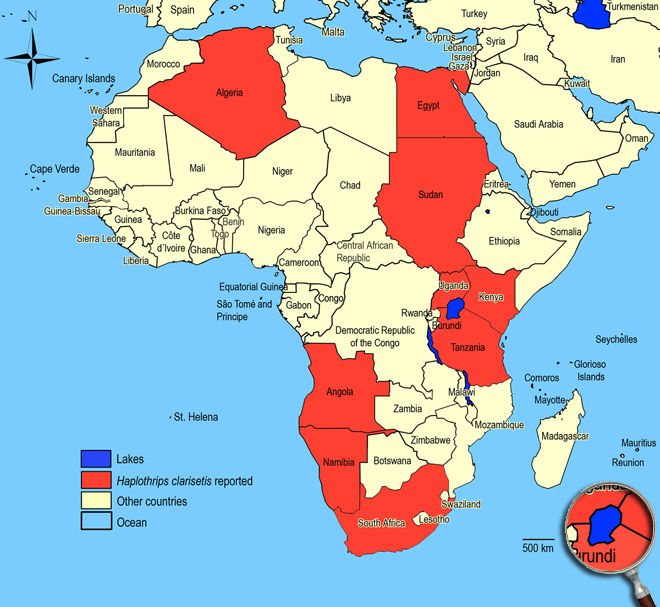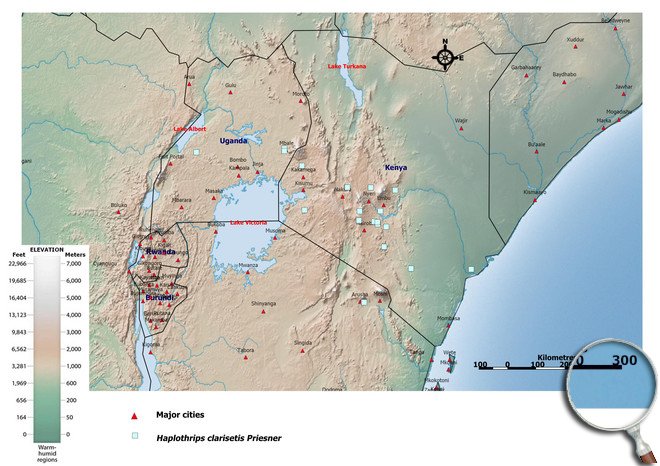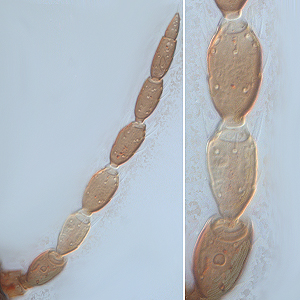Haplothrips (Trybomiella) clarisetis Priesner, 1930
Phlaeothripinae, Phlaeothripidae, Tubulifera, Thysanoptera
Figures
Fig. 1: 8-segmented antenna, segments II-IV
Fig. 2: Head dorsal with ocellar triangle and bridge between maxillary stylets
Fig. 3: Pronotum
Fig. 4: Meso- and metanotum
Fig. 5: Tergite I with pelta
Fig. 6: Tergites III-V with wing retaining setae
Fig. 7: Tergites III-V, left side with wing retaining setae
Fig. 8: Tergites IX and X (tube)
Introduction and recognition
Haplothrips (Trybomiella) clarisetis is polyphagous and found in flowers of a wide range of plants, mainly on Amaranthaceae. Female macropterous; body and legs dark brown; fore tarsi light brown to yellow; antennal segment III light brown (Fig. 1); fore wings pale with extreme base and scale dark brown; major setae light brown. Antennae 8-segmented, segment III with 2 sense cones, IV with 4 sense cones. Head longer than wide (Fig. 2); postocular setae capitate, shorter than width of compound eye, arising close to posterior margin of compound eye; maxillary stylets retracted to postocular setae, about one third of head width apart with distinct maxillary bridge (Fig. 2). Pronotal midlateral setae no larger than discal setae, remaining 4 pairs of major setae well-developed and capitate (Fig. 3), epimeral suture complete. Prosternal basantra well developed and distinctly broader than long; mesopraesternum reduced to 2 lateral triangles; metathoracic sternopleural sutures not developed. Fore tarsus without tooth. Fore wing broad and strongly constricted medially; without duplicated cilia. Pelta triangular (Fig. 5); tergites II-VII each with 2 pairs of sigmoid wing-retaining setae (Fig. 6 and 7); tergite IX setae acute and as long as tube; tube about half as long as head; anal setae no more than 1.5 times as long as tube (Fig. 8).
Male macropterous; similar to female; fore tarsal tooth small with broad base; tergite IX setae S2 short and stout; sternite VIII without glandular area.
Taxonomic identity
Species
Haplothrips (Trybomiella) clarisetis Priesner, 1930
Taxonomic history
Haplothrips infernalis Priesner, 1965
Haplothrips dolichothripoides Bagnall, 1933
Common name
-
Present taxonomic position
Family: Phlaeothripidae Uzel, 1895
Subfamily: Phlaeothripinae (Uzel) Priesner, 1928
Genus: Haplothrips Amyot & Serville, 1843
Subgenus: Haplothrips (Trybomiella) Bagnall, 1926
Genus description
The genus Haplothrips (Trybomiella) Bagnall, 1926
With nearly 250 described species, Haplothrips is the third largest genus of Thysanoptera. Most of these species, largely from Europe and the Old World tropics, are flower-living, including the flowers of grasses and sedges. Members of the genus are mostly macropterous and have duplicated fringe cilia on the fore wing (subgenus Haplothrips), with the fore wing constricted medially and contain well developed paired prosternal basantra (Mound & Kibby 1998). The species in this group which contain single fringed cilia on the fore wing belong to the subgenus Trybomiella. In addition, Haplothrips species have 4 sense cones on antennal segment IV, the head contains a well developed maxillary bridge, complete epimeral sutures on the pronotum, a triangular shaped pelta, and tergites II through VII exhibit 2 pairs of wing-retaining setae.
Species description
Typical key character states of Haplothrips (Trybomiella) clarisetis
Coloration
Body color: mainly brown to dark brown
Antennae
Number of antennal segments: 8
Segment III - number of sense cones: 2
Segment IV - number of sense cones: 4
Form of sensorium on antennal segments III and IV: emergent and simple on segments III and IV
Head
Maxillary stylet position: about one third of head width apart
Postocular setae: about half to nine tenths as long as compound eye
Maxillary bridge: present
Cheeks: without seta-bearing tubercle
Prothorax
Number of pairs of elongate pronotal setae: 4
Prosternal basantra: present, wider than long
Epimeral suture: complete
Mesothorax
Shape of mesopraesternum: reduced to two lateral triangles
Wings
Fore- and hind wings: present and more than half as long as abdomen
Fore wing veins: absent
Fringe cilia arising: not from sockets
Fore wing shape: constricted medially
Fore wing duplicated cilia: absent
Fore wing color: uniformly pale or weakly shaded
Fore wing extreme apex color: pale
Legs
Fore femur: without a tooth or hook
Abdomen
Abdominal tergites III-V: with 2 pairs of sigmoid curved wing-retaining setae
Abdominal segment 10: complete tube in both sexes

Similar or related species
Compared to Haplothrips gowdeyi (subgenus Haplothrips) with duplicated fringe cilia on the fore wing, Haplothrips clarisetis (subgenus Trybomiella) has only single fringed cilia on the fore wing. Other distinguishing features are: only 4 pairs of elongate pronotal setae because the pronotal midlateral setae are no larger than discal setae (Haplothrips gowdeyi with 5 pairs of elongate pronotal setae), mesopraesternum is reduced to 2 lateral triangles (in Haplothrips gowdeyi mesopraesternum is complete and boat-shaped but very narrow medially), and fore tarsus in females without a tooth (females of Haplothrips gowdeyi with a small tooth).
Karnyothrips flavipes is closely related and similar to Haplothrips species in structure, but has a prosternal basantra that is about as broad as long or longer than wide (Haplothrips with a basantra that is distinctly broader than long), anal setae 1.5 to 2.0 times as long as tube or longer (Haplothrips with anal setae no more than 1.5 times as long as tube), anteromarginal pronotal setae not longer than discal setae (Haplothrips with anteromarginal setae usually longer than discal setae), and a fore tarsal tooth near the apex that is forwardly directed and hook-like (Haplothrips without or with a small lateral tooth).
Almost all species of the Phlaeothripidae have a mainly brown body color, uniform fore wings, and tergites II-VII each with 2 pairs of wing-retaining setae (only Aleurodothrips fasciapennis with a bicolored body, fore wings with transverse alternating bands of dark and light, and tergites II-VII each with 1 pair of wing-retaining setae), and no seta-bearing tubercle on cheeks (only Hoplandrothrips marshalli has cheeks with at least 1 seta-bearing tubercle in basal third or 3 pairs laterally). Haplothrips species as well as Karnyothrips flavipes and species of Gynaikothrips have a maxillary stylet that is about one third of head width apart, and the length of postocular setae is about half to nine tenths as long as eye (in Aleurodothrips fasciapennis the maxillary stylet is more than half of head width apart, and postocular setae are shorter than distance of the setal base from the eye; in Hoplandrothrips marshalli the maxillary stylet is about one fifth of head width apart, and postocular setae are as long as dorsal length of eye or a little longer). Species of Haplothrips and Karnyothrips flavipes possess a maxillary bridge and prosternal basantra (species of Gynaikothrips, Hoplandrothrips marshalli and Aleurodothrips fasciapennis have neither a maxillary bridge nor a prosternal basantra). Haplothrips (Haplothrips) gowdeyi as well as Karnyothrips flavipes and Hoplandrothrips marshalli, and species of Gynaikothrips have duplicated cilia on posterior margin of fore wing (Aleurodothrips fasciapennis and Haplothrips (Trybomiella) clarisetis without duplicated cilia on posterior margin of fore wing).
Biology
Life history
As with other thrips species the life cycle from egg to adult is dependent on temperature. The full cycle can take less than one week to over a month and adults may live for more than one month producing several generations in one year depending on seasonal weather (Lewis 1973).
Host plants
Crops: African spiderplant, amaranth, cabbage, chillies, citrus, cotton, maize, potato, rice, sunflower, tomato.
Weeds: Ageratum conyzoides, Ajuga remota, Aspilia mossambicensis, Bidens pilosa, Lantana camara, Nicandra physalodes, Senecio moorei, Tagetes minuta, Tithonia diversifolia.
Damage and symptoms
-
Detection and control strategies
-
Additional notes
Haplothrips clarisetis is reported from a very large number of different plants in southern Africa (Faure 1955), including various grasses, but without any indication of the larval host plants.
Biogeography
Old World subtropics and tropics from India via Egypt to Namibia. Algeria (El Qued),
Angola,
Egypt (Sinai, Nile valley),
Namibia, South Africa (Limpopo: Louis Trichardt, Leydsdorp; Gauteng: Pretoria; Mpumalanga: White River; North West: Rustenburg; Free State: Bloemfontein, Fauresmith; North West: Rietspruit - Marico district;Northern Cape: Windsorton, Bosbult, Calvinia; Western Cape: Vredendal, Laingsburg, Graafwater, Fish Hoek, Zwartberg Pass, Plettenberg Bay),
Sudan (Wad Medani), Tanzania, Uganda.
African countries where Haplothrips (Trybomiella) clarisetis has been reported

Occurence of Haplothrips (Trybomiella) clarisetis in East Africa

Please click here for survey sites of all observed thrips species of Kenya, Tanzania and Uganda.
Click here for locations of Haplothrips (Trybomiella) clarisetis in parts of East Africa.

Bibliography
Bagnall RS (1933). A contribution towards a knowledge of the thysanopterous genus Haplothrips Serv. Annals and Magazine of Natural History, Zoology, Botany and Geology. (Serie 10) 11: 313-334
Balachowsky AS (1951). Note sur quelques Thysanoptera récoltés dans le Tassili N'Ajjers (Sahara Central) et dans le Sahara Marocain Océanique. Revue de Pathologie Végétale et d´Entomologie Agricole de France. 30: 159-160
Faure JC (1955). South African Thysanoptera - 4. Journal of the Entomological Society of Southern Africa. 18 (2): 208-234
Halperin J & zur Strassen R (1981). Thysanoptera of forest and ornamental woody plants in Israel with a list of the species recorded from Israel. Israel Journal of Entomology. 15: 21-33
Lewis T (1973). Thrips: their biology, ecology and economic importance. Academic Press Inc., London Ltd., 349 pp
Moritz G (2006). Thripse. Pflanzensaftsaugende Insekten, Bd. 1, (1. Auflage). Westarp Wissenschaften, Hohenwarsleben, 384 pp. ISBN 13: 978 3 89432 8917
Moritz G, Morris DC & Mound LA (2001). ThripsID - Pest thrips of the world. ACIAR and CSIRO Publishing Collingwood, Victoria, Australia, CDROM ISBN 1 86320 296 X
Mound LA & Kibby G (1998). Thysanoptera: An identification guide, (2nd edition). CAB International, Wallingford and New York, 70 pp
Palmer JM, Mound LA & du Heaume GJ (1989). 2. Thysanoptera, 73 pp. In Betts CR [ed.], CIE Guides to insects of importance to man. CAB International, Wallingford, Oxon, UK
Pelikan J (1988). Records, notes and list of Thysanoptera from Algeria. Acta Entomologica Bohemoslovaca. 85: 21-27
Priesner H (1931). A review of the African Haplothrips-species (Thysanoptera). Bulletin de la Société Royale Entomologique ďEgypte. 14 (4): 230-277
Priesner H (1938). Contributions towards a knowledge of the Thysanoptera of Egypt, XI. Bulletin de la Société Royale Entomologique ďEgypte. 21: 208-222
Priesner H (1964). A monograph of the Thysanoptera of the Egyptian deserts. Publications de l’Institut du Desert d’Egypte (1960). 13: 1-549
zur Strassen R (1960). Catalogue of the known species of South African Thysanoptera. Journal of the Entomological Society of Southern Africa. 23 (2): 321-367
zur Strassen R (1979). Insects of Saudi Arabia, Thysanoptera. Fauna of Saudi Arabia. 1: 90-104
----
Web links
Mound´s Thysanoptera pages
Thysanoptera Checklist
ICIPE Thrips survey sites
UNI Halle & Thrips sites
Thrips of California












